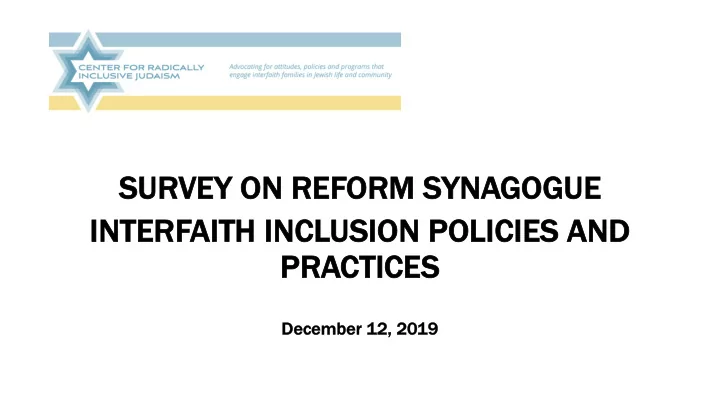

SU SURVEY O ON R REFORM S SYNAGO GOGU GUE IN INTE TERFAITH ITH IN INCLUSIO SION P POLIC ICIE IES A S AND PRACTIC TICES December 1 12, 2 2019
Me Methodology • Survey link sent to lists of congregational rabbis and presidents compiled by CFRIJ by consulting the URJ Congregation Directory • Responses received from 418 congregations, representing just under 50% of the URJ’s 843 member congregations • Size of responding congregations largely parallels size of URJ congregations as a whole, with some skewing to larger ones • After inconsistent multiple responses eliminated, survey report analyzes responses from 385 congregations • Complete survey report available at http://www.cfrij.com/wp-content/uploads/2019/12/URJ-Survey- Report.pdf
Leadership R Roles Partners f from d different f faith t traditions can serve as do serve as Board m members 43% 21% Of Officer ers* 24% 13% * But not necessarily as President
Ritual P Participation Partners f from d different f faith t traditions c can Yes No Lead c candle 68% 32% lig light hting ing* Have/join i in A Aliyah* 70% 30% Pass T Torah 78% 22% * But not necessarily by themselves or saying the words
Dual E Education; O Officiation Have c children i in r religious s school r receiving f formal r religious education i in a another r religion Ye Yes 20% No* No 80% * As far as we know Some o or a all c clergy, a at w weddings o of i interfaith c couples Of Officiate 88% Co Co-of officiate* e* 22% * But maybe offer a blessing
Messaging, P Programming a and T Training Publish p policies a and p practices r re: 18 18% interfaith f families i in t terms o of l leadership and r ritual p participation o on w website Offer p programs t that a address i issues t that 40% relate p particularly t y to i interfaith f families Have a a c committee t that a addresses 14% engaging i interfaith f families Provide t training o on h how t to s serve t the 10% (for lay leaders)/ specific n needs o of i interfaith f families 13% for staff
Di Discussion • What will lead to more engagement, permission or boundary maintenance/restriction? • Half full or half empty? Is it good that 68% allow members of a different faith to lead candle lighting, or bad that 32% don’t? • Do we need to change our posture on children being raised “both”? • Given 32 significantly inconsistent multiple responses from the same congregations, and only 18% publishing their policies, do we talk explicitly and effectively enough about our attitudes and policies on interfaith inclusion? • Are we justifiably self-satisfied, or complacent? Are we doing enough, or do we need to do more?
Recommend
More recommend